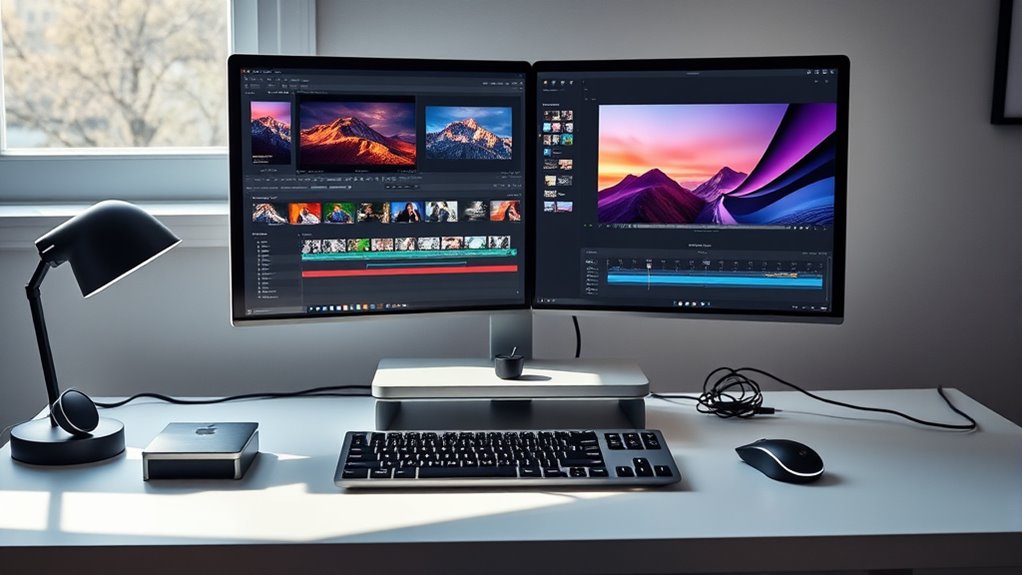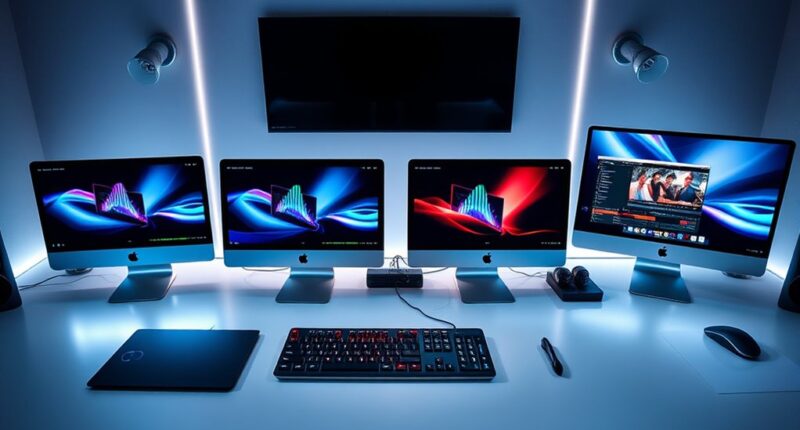If you’re looking for the best Mac Studio options for video editing in 2025, I recommend considering models with the M4 Pro and M4 chips. The Mac mini with M4 Pro offers top-tier power, excellent graphics, and support for multiple high-res displays, perfect for demanding workflows. The standard M4 models deliver solid performance at a lower price point. If you want the full picture and how these fit your needs, keep exploring to find the perfect fit for your creative projects.
Key Takeaways
- The M4 Pro-powered Mac mini delivers top-tier performance for demanding 4K and 8K video editing workflows.
- Configurable RAM up to 64GB ensures smooth multitasking and future-proofing for evolving editing software.
- Multiple high-resolution display support, including dual 6K monitors, enhances workflow and visual precision.
- Compact, lightweight design (around 5×5 inches, 1.5 pounds) maximizes space efficiency and portability.
- Connectivity options like Thunderbolt, HDMI, and Ethernet facilitate seamless integration with professional editing peripherals.
Apple Mac mini Desktop Computer with M4 Pro chip
If you’re looking for a compact yet powerful desktop for video editing in 2025, the Apple Mac mini with the M4 Pro chip is an excellent choice. Its small size—just 5 inches square—and lightweight design make it easy to place anywhere. Powered by the 12-core M4 Pro CPU and 16-core GPU, it handles demanding tasks like 4K editing, rendering, and AI workloads effortlessly. With up to 64GB of unified memory and fast SSD options, it offers impressive performance. Supports multiple high-resolution displays, runs macOS smoothly, and operates quietly. This mini desktop balances power, size, and efficiency, perfect for creative professionals needing a space-saving yet capable machine.
Best For: creative professionals and power users seeking a compact, high-performance desktop for video editing, 3D rendering, and AI workloads.
Pros:
- Small, lightweight design fits seamlessly into any workspace
- Powerful M4 Pro chip with fast CPU and GPU for demanding tasks
- Supports multiple high-resolution displays and macOS ecosystem
Cons:
- Limited ports with no USB-A ports, requiring adapters or hubs
- Power button located on the bottom, which may be less intuitive
- Base model’s memory and storage may be limiting for intensive workflows
Apple Mac mini Desktop Computer with M4 Chip and 16GB RAM
The Apple Mac mini with M4 chip and 16GB RAM stands out as an ideal choice for budget-conscious video editors who still demand strong performance. Its compact design, measuring just 5 inches square and weighing 1.5 pounds, fits easily on any desk or workspace. Powered by the efficient M4 chip, it offers about 20% faster CPU performance and up to 14% better GPU performance than earlier models, handling demanding editing tasks smoothly. With extensive connectivity—Thunderbolt, HDMI, Ethernet—it supports multiple displays and peripherals. Quiet operation, sleek aluminum build, and seamless macOS integration make it a versatile, space-saving solution perfect for light to moderate video editing workflows.
Best For: budget-conscious video editors seeking a compact, powerful desktop with reliable performance for light to moderate editing tasks.
Pros:
- Compact and lightweight design fits easily into any workspace
- Fast CPU and GPU performance improvements for demanding editing workflows
- Seamless macOS integration with extensive connectivity options
Cons:
- No USB-A ports, requiring adapters for legacy peripherals
- Base model’s 16GB RAM may be limiting for intensive multitasking or heavy workflows
- Power button relocated to the bottom, which may reduce intuitiveness
Apple Mac mini Desktop Computer with M4 Chip
For those seeking a compact yet powerful desktop for video editing, the Apple Mac mini with M4 chip is an excellent option. Its sleek aluminum design measures just 5 x 5 inches and weighs only 1.5 pounds, making it highly space-efficient and portable. Powered by the M4 chip, it offers approximately 20% CPU performance improvements and significant GPU gains, handling demanding tasks like 4K editing and rendering with ease. It supports up to three displays, including two 6K monitors, and features extensive connectivity, including Thunderbolt 4, HDMI, and Ethernet. Despite some port removal and a less intuitive power button, it delivers impressive performance in a tiny footprint.
Best For: users seeking a compact, high-performance desktop for demanding creative tasks like video editing and 4K rendering.
Pros:
- Extremely small and portable design ideal for space-constrained setups
- Powerful M4 chip with significant CPU and GPU performance gains
- Supports multiple high-resolution displays, including two 6K monitors
Cons:
- Removal of USB-A ports may require adapters for older peripherals
- Power button relocated to the bottom, which may reduce intuitiveness
- Base model with 16GB RAM could limit performance in intensive workflows
Apple Mac mini Desktop Computer with M4 Chip (2024)
Designed for creative professionals who need a compact yet powerful desktop, the Apple Mac mini with M4 chip (2024) delivers impressive performance in a small form factor. Measuring just 5 inches square and weighing 1.5 pounds, it combines portability with robust capabilities. It features extensive connectivity, including Thunderbolt 4, HDMI, Ethernet, and USB-C ports, though it lacks USB-A. Powered by the M4 chip with a 10-core CPU and GPU, it offers a 20% CPU boost and supports multiple high-resolution displays. Its energy-efficient design runs quietly, making it ideal for demanding video editing tasks while fitting seamlessly into tight workspaces.
Best For: creative professionals and power users seeking a compact, high-performance desktop with excellent connectivity options and support for multiple high-resolution displays.
Pros:
- Compact, lightweight design perfect for small workspaces and portability
- Powerful M4 chip with improved CPU and GPU performance for demanding tasks
- Quiet operation and energy efficiency enhance user experience
Cons:
- Lacks USB-A ports, requiring adapters for some peripherals
- Power button placement may be less intuitive for users
- Base model’s 16GB memory may be limiting for intensive workflows
Factors to Consider When Choosing a Mac Studio for Video Editing

When choosing a Mac Studio for video editing, I consider several key factors to guarantee it meets my needs. These include processing power, RAM capacity, storage options, graphics performance, and display compatibility. Understanding these points helps me pick a model that offers smooth workflow and future-proof performance.
Processing Power Needs
Choosing the right Mac Studio for video editing hinges on understanding its processing power. High-performance CPUs and GPUs are essential for handling large files, especially when working with 4K or 8K footage. I recommend a Mac Studio with at least a 12-core CPU and a 20-core GPU to guarantee smooth playback, quick rendering, and efficient exporting. Hardware-accelerated ray tracing and dedicated media engines boost decoding and encoding speeds for formats like ProRes and HEVC, saving valuable time. For complex projects involving 3D effects, color grading, or multi-layer editing, robust processing capabilities prevent lag and speed up workflows. Remember, while processing power is vital, pairing it with ample RAM will maximize performance during intensive editing tasks.
RAM Capacity Importance
Having enough RAM is essential for smooth video editing, especially when working with large files or complex projects. For 4K editing, a minimum of 16GB of RAM is recommended, but 32GB or more is ideal for 8K workflows or multi-camera setups. Insufficient RAM leads to slow rendering, lag, and limits the ability to run multiple editing programs simultaneously. Many video editing software packages specify minimum RAM requirements, and exceeding these can appreciably boost performance and responsiveness. Upgrading RAM capacity also future-proofs your setup, accommodating larger files and more demanding software updates down the line. In short, RAM plays a vital role in maintaining efficient workflows, reducing downtime, and ensuring your Mac Studio can handle evolving video editing demands with ease.
Storage Options Flexibility
Selecting the right storage options is a key factor in optimizing your video editing workflow on a Mac Studio. Multiple configurations are available, from 512GB to 8TB SSDs, so you can choose based on your project size and future needs. Higher storage capacities often come with increased costs, so evaluating your current and upcoming projects helps balance budget and capacity. Upgrading storage at the point of purchase offers flexibility and future-proofing your setup. While external drives can expand storage, built-in SSDs provide faster read/write speeds essential for large video files, reducing transfer times and workflow interruptions. Opting for a larger internal SSD can markedly improve efficiency, ensuring smoother editing and seamless file access throughout your projects.
Graphics Card Performance
A powerful graphics card is essential for smooth video editing on a Mac Studio, especially when working with high-resolution footage like 4K or 8K. A GPU with hardware-accelerated ray tracing can drastically improve rendering times and enhance visual effects, making workflows more efficient. The number of GPU cores directly influences real-time playback and preview quality, so more cores mean smoother editing of complex projects. GPU architecture and core count determine how well a Mac Studio handles tasks like color grading, compositing, and multi-layer effects. Dedicated VRAM size is equally important, as it allows you to work with large project files and multiple high-res timelines without lag. Optimized GPU performance accelerates rendering and exports, reducing project turnaround times for professional editors.
Display Compatibility Limits
When choosing a Mac Studio for video editing, understanding its display compatibility limits is essential, especially if you plan to work with multiple high-resolution monitors. The Mac Studio supports up to four external displays, but the resolution and connection type can impose restrictions. Connecting several 6K displays often requires Thunderbolt 4 or USB-C ports, which may be limited by available connections. The maximum supported resolutions are 8K at 60Hz or 6K at 60Hz per display, shaping multi-monitor setups. Using HDMI, the top resolution is 4K at 240Hz or 8K at 60Hz, which might restrict high-res configurations. Hardware and port limitations mean careful planning is necessary to ensure your display setup meets your video editing needs without sacrificing quality or workflow efficiency.
Connectivity and Ports
Understanding a Mac Studio’s connectivity options is key to building an efficient video editing setup. You’ll want enough Thunderbolt 4 or 5 ports to connect multiple high-speed external drives and peripherals, guaranteeing smooth data transfer. Check if the model supports multiple 6K or 8K displays at once, which is essential for multi-monitor editing workflows. An HDMI 2.1 port is also critical for high-resolution, high-refresh-rate external displays, providing detailed viewing options. Additionally, ensure there are enough USB-C or USB-A ports—adapters can help if needed—for audio interfaces, microphones, or card readers. Finally, consider Ethernet options, such as Gigabit or 10Gb Ethernet, for fast file transfers when working with large media files stored on networked storage. This connectivity versatility is vital for seamless editing performance.
Software Compatibility Factors
Choosing the right Mac Studio for video editing means guaranteeing your software runs smoothly and efficiently. First, check that your preferred editing programs support the latest macOS version, as updates often include critical optimizations. It’s also essential to verify that your software is optimized for Apple Silicon, especially the M4 Pro chip, which can drastically reduce rendering times. Look for support of hardware-accelerated formats like ProRes, HEVC, and AV1, since these are handled efficiently by the Mac Studio’s media engines, speeding up workflows. Additionally, confirm compatibility with multiple external displays, especially high-resolution monitors, which require specific GPU and port support. Finally, ensure that your favorite plug-ins and third-party extensions work seamlessly with the Mac Studio’s architecture to avoid workflow interruptions.
Budget Constraints
Budget constraints can considerably influence which Mac Studio model best suits your video editing needs, often limiting you to lower-tier configurations with less RAM, storage, or fewer ports. These choices can impact performance, especially during complex editing tasks, and may affect future-proofing. While investing in higher-end models boosts speed and capability, it also markedly increases costs. Cheaper models might lack advanced cooling systems, risking thermal throttling during intensive sessions. Additionally, budget setups often mean extra expenses for accessories like external drives, adapters, or upgraded displays. To make the most of your budget, prioritize essential features such as processing power, memory, and connectivity, ensuring your setup meets your current needs without overspending. Setting a realistic budget helps balance cost and performance effectively.
Frequently Asked Questions
Which Mac Studio Model Offers the Best Value for Professional Video Editors?
I believe the Mac Studio with the M2 Ultra chip offers the best value for professional video editors. It delivers incredible power and speed, handling high-resolution editing and complex projects effortlessly. While it’s an investment, its performance justifies the cost, especially if you work with demanding content regularly. For those seeking a balance of performance and affordability, the M2 Max version is also a solid choice, providing excellent value.
How Does the M4 Pro Chip Improve Video Editing Workflows Compared to Previous Models?
The M4 Pro chip markedly boosts my video editing workflow by offering faster processing and smoother rendering. It handles high-resolution footage with ease, reducing lag and waiting times. I notice improved efficiency in multitasking and exporting projects. The enhanced GPU power also accelerates effects and color grading. Overall, it makes editing more seamless, allowing me to focus on creativity rather than technical limitations.
Are There Specific Ports or Expandability Options Ideal for Video Editing Setups?
Did you know the Mac Studio offers up to four Thunderbolt ports? For video editing, I find this essential because I can connect multiple external drives and high-resolution monitors without hassle. I prefer models with USB-C and SD card slots too, making workflow smoother. Expandability really boosts efficiency, especially when dealing with large files or multiple inputs. So, look for a setup with versatile ports to enhance your editing experience.
What Are the Thermal Management Features in the Latest Mac Studio Models?
The latest Mac Studio models feature advanced thermal management with a large, efficient cooling system that includes a sophisticated airflow design and high-performance fans. I appreciate how they maintain ideal temperatures during intensive editing sessions, preventing overheating and ensuring smooth performance. These thermal features help me work longer and more efficiently without worrying about thermal throttling, making them a reliable choice for demanding video editing tasks.
How Do Software Compatibility and Updates Affect Choosing the Right Mac Studio?
Did you know that 85% of creative professionals prioritize software compatibility when choosing hardware? I believe it’s vital because software updates can boost performance or introduce new features, but they might also cause compatibility issues. When selecting a Mac Studio, I always check if my essential editing tools are optimized for the latest macOS versions. Staying current guarantees smooth workflow and future-proofing my investment.
Conclusion
So, which Mac Studio will elevate your video editing game in 2025? Picture yourself seamlessly handling 8K footage, multitasking with ease, and pushing creative boundaries without a hitch. Each model promises power and precision, but the real decision lies ahead—what’s the perfect fit for your projects? The future of editing is just around the corner, and your ideal Mac Studio might be waiting to unleash possibilities you haven’t even imagined yet.











